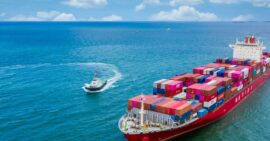Asia is a powerhouse of global trade, contributing to over one third of the world’s exports and imports. It is both a nexus of supply and demand and an epicentre of innovation and resilience. However Asia’s global trade is also a region facing complex geopolitical challenges and uncertainty.
Thomson Reuters has today released the State of Asia’s Position as a Global Trade Leader report. The report charts the trends shaping the future of supply chain management and Asia’s global trade.
The report spotlights environmental, social and governance (ESG) practices illuminating a path toward a greener and more sustainable future. It also reveals a region committed to innovation and marks a defining shift powered by technology.
“Technology adoption is a key driver for success, empowering (organisations) to streamline processes, reduce costs, enhance compliance, and improve customer satisfaction.”
Carl Olson, Vice President, Proposition, Thomson Reuters – Asia and Emerging Markets
What is the state of Asia’s global trade?
Supply chain disruption and increased rates of protectionism are prominent in the Asian global trade landscape. Organisations are taking multi-pronged approaches to their global trade operations to ensure success.
Companies are utilising free trade agreements and focusing on local markets to offset tariff costs. More and more trade professionals are using technology to better track their supply chains and comply with regulations.
Survey snapshots
Protectionism is impeding operations
Three in five leaders surveyed (60%) confirmed that a rise in protectionism has impacted their supply chain and global trade operations.
Supply chain disruptions still rife
Almost three in four (71%) professionals surveyed cited supply chain disruptions affecting profitability, underlining the challenges they face in traditional supply sources;
Tech reigns supreme
Almost half the leaders (46%) anticipate AI will radically disrupt trade operations and 44% expect their spend on such technology to increase in the coming year.
ESG’s ascent
Organisations are adopting more environmentally friendly practices. Over three in five leaders (63%) are reducing their reliance on paper and increasing software adoption.
The survey explores insights from 650 professionals who lead or influence global trade and supply chain decisions. It covers a broad range of sectors, from pharmaceuticals and life sciences to consumer products and e-commerce.
How can your industry be more strategic?
Asia’s global trade professionals are resilient, adaptable and forward-looking. They are shifting their priorities and strategies to overcome obstacles and seize new opportunities. Here’s what the professionals we surveyed advised:
- “Invest in forecasting and inventory control technology.” Assistant Vice President, Southeast Asia, automotive organisation with $300 million revenue
- “Keep up with the most recent customs and trade law.” Chief Executive Officer, Japan, logistics
organisation with $5 billion revenue - “Use dual-sourcing tactics for components that are in high demand.” Chief Procurement Officer, Mainland China & Taiwan region
The report is a resource for professionals in global trade and supply chain management, as well as business leaders, policymakers, and stakeholders seeking market insights on global trade in Asia.
Download your copy here on Business Insight.
Related reading:
Globalisation under siege: Culture, geopolitics, supply chains, and security
Is global tax transparency accelerating digital transformation?


